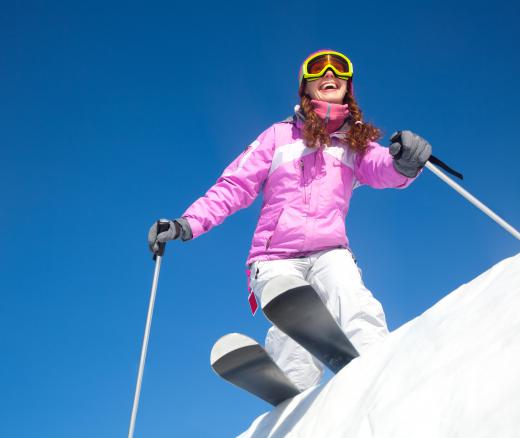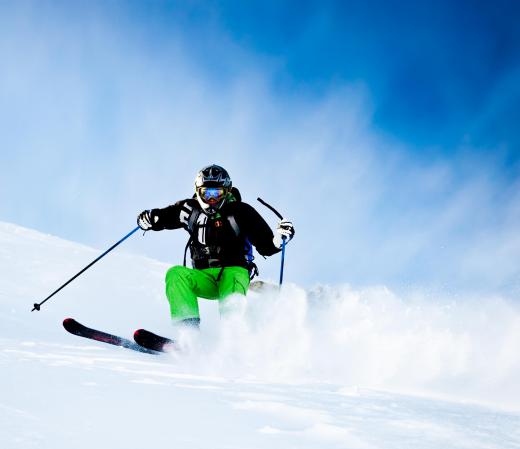At Sports&Hobbies, we're committed to delivering accurate, trustworthy information. Our expert-authored content is rigorously fact-checked and sourced from credible authorities. Discover how we uphold the highest standards in providing you with reliable knowledge.
What are Twin-Tip Skis?
Twin-tip skis are a ski design which began to gain popularity in the late 1990s. Conventional alpine skis have a curved front end and a flat rear end. These skis have curved fronts and rears, which enable the skier to do more tricks, turn more effectively, have stable landings, and ski backward as well. The versatile skis led to a resurgence in popularity for skiing amongst younger sportspeople, and led to changes in ski resort design as well.
Twin-tip skis were developed by Clint Fiala, who constructed these skis in his garage before realizing the commercial potential of the skis. The design was picked up by Salomon, a venerable ski company, as the Teneighty. Today there are a wide range of twin-tips on the market, although Teneighties are linked with high quality.

In addition to being upturned at the front and the back, twin-tip skis also have a distinctive hourglass design, narrowing slightly in the middle. These skis can come in designs which are very wide for increased stability on a variety of terrain, or they can be narrow for speed. Either way, they are highly adaptive, allowing skiers to turn on a dime, spin in halfpipes, and do a variety of other skiing stunts.

Twin-tip skis are often linked with snowboards, because both enable athletes to do an astounding array of tricks. Many snowboarders have taken up twin-tip skis as well because it is actually possible to do more tricks on skis, due to the greater amount of speed which can be achieved. As a result, skiers and snowboarders are often seen sharing space in halfpipes and other areas at ski resorts set aside for tricks.

Due to the increased demand caused by twin-tip skis, ski resorts have begun changing the way they groom their facilities. More space is set aside for stunt areas, halfpipes are much larger, and youthful skiers are welcome at many resorts. Several stunt skiers who use twin-tip skis are sponsored by resorts, and make excellent advertising for their facilities.
Some traditional skiers are uncomfortable with the rise of twin-tip skis. Skiing with these skis is markedly different than progressing in a stately and elegant fashion down the slopes. It is a rugged, active version of skiing which can potentially be far more dangerous, as well as providing a rewarding adrenalin rush. At resorts where adequate provisions have not been made for twin-tip skiers, this has led to conflict on the slopes.
AS FEATURED ON:
AS FEATURED ON:













Discussion Comments
Twin tip skis do not necessarily allow for quicker turning or spinning. The twin tip merely allows for rearwards, or "fakie" landings, takeoffs, cruising and carving, and tricks.
The binding mounting position on the skis greatly affects the ski's maneuverability while in fakie as a traditional ski's binding is normally set significantly off-center toward the rear of the ski.
Twin tip ski shapes vary greatly, and while the twin tip ski emerged at the time that the hourglass shaped ski ballooned in popularity, twin tip skis can be had in any number of widths from as little as 60mm underfoot to greater than 150mm underfoot.
Additionally, twin tip ski shapes include traditional hourglass, rockered, taper-tail and tip, and any number of other variations on traditional and non-traditional ski shapes.
Finally, the flex pattern of twin tip skis is often specifically tailored to the types of freestyle skiing typically associated with twin tip skis.
A twin tip ski will typically carve much differently than a slalom race ski, as they are designed for two different purposes.
Post your comments